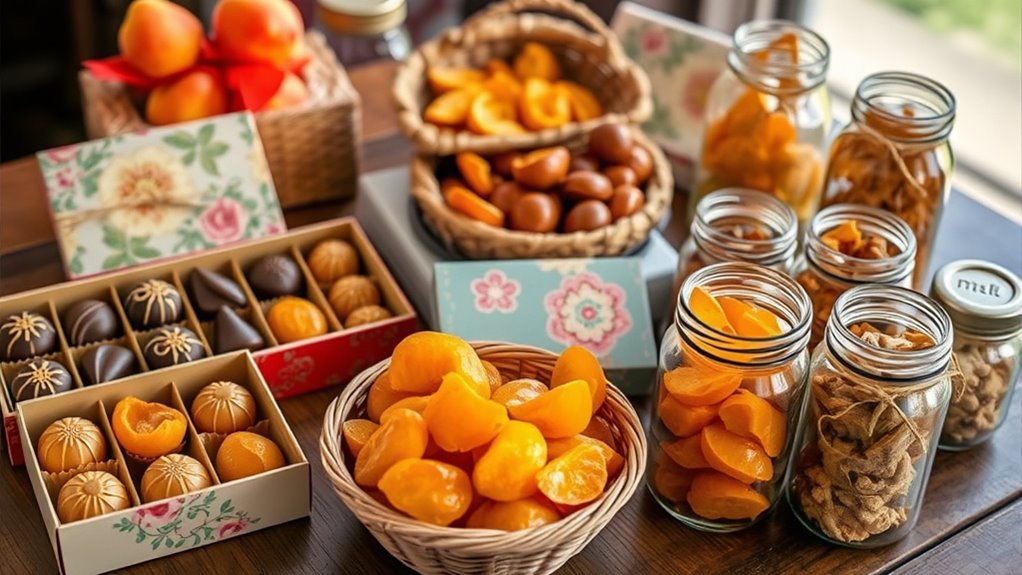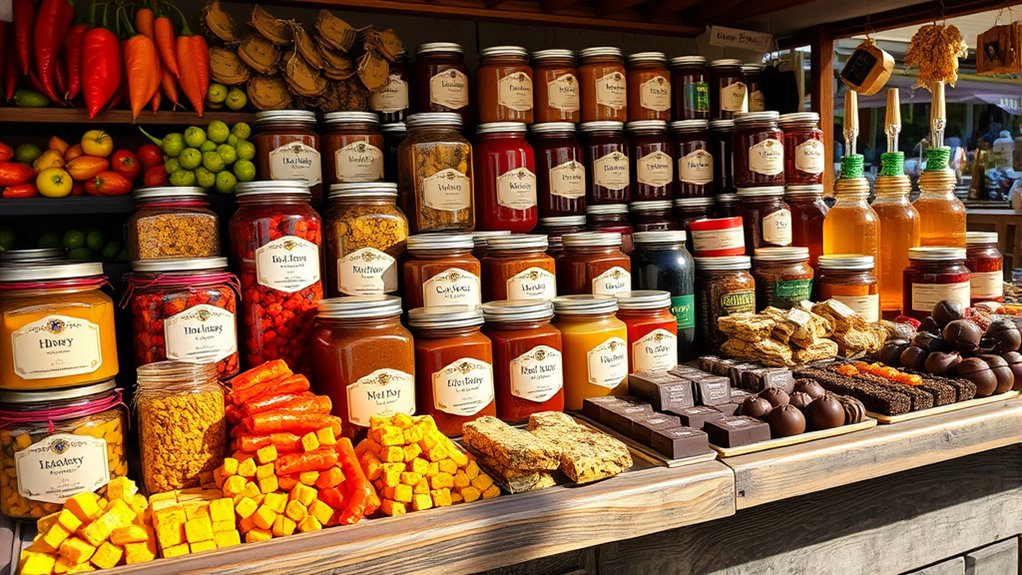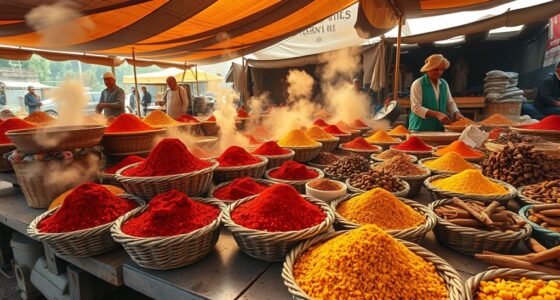Bringing home culinary souvenirs like local spices, jams, or dried herbs lets you preserve the true flavors and cultural essence of your travels. These edible treats support local artisans and often carry stories of their origins, making them meaningful mementos. To guarantee easy transport, choose lightweight, preserved items or small tools that highlight the region’s culinary craftsmanship. Keep exploring to discover even more authentic flavors and practical tips for your culinary keepsakes.
Key Takeaways
- Choose authentic, locally produced edible treats like honey, spices, or jams that represent the destination’s culinary identity.
- Opt for non-perishable items such as dried herbs or packaged snacks that are easy to transport and have a long shelf life.
- Support small vendors and artisans by purchasing handcrafted foods that carry cultural significance and uniqueness.
- Verify customs regulations to ensure edible souvenirs can be legally brought home without issues.
- Incorporate edible souvenirs into your home cooking to preserve memories and experiment with new recipes inspired by your travels.

Have you ever brought home a food item from a trip that instantly transports you back to a special place? That’s the magic of culinary souvenirs—they carry more than just flavor; they hold memories. When you wander through local food markets, you’re immersing yourself in the authentic heartbeat of a place. These markets burst with vibrant colors, exotic aromas, and an array of ingredients you rarely see elsewhere. It’s here that you can find unique spices, homemade jams, or regional snacks that embody the local culture. Picking up a few of these items feels like capturing a piece of the destination’s soul, a tangible reminder of your adventures.
Culinary souvenirs from local markets capture the soul of a place and evoke cherished travel memories.
But it’s not just about the ingredients. Many traditional cooking tools found in these markets are treasures in their own right. Think mortar and pestle carved from local stone, hand-woven bamboo steamers, or ceramic pots handed down through generations. These tools aren’t just functional—they tell stories. Using them at home transforms your kitchen into a small piece of your travel experience, connecting you with the culinary traditions of the region. Plus, they often serve as great conversation starters when friends visit, sparking curiosity about your trip and the stories behind each piece.
When you bring home these edible treats and tools, you’re doing more than just adding to your pantry. You’re embracing the essence of local cuisine, supporting small vendors, and preserving craftsmanship. These items often come with a sense of authenticity that mass-produced souvenirs lack. For example, a jar of locally made honey or a packet of dried herbs from the market can elevate your cooking and make everyday meals special. Similarly, traditional cooking tools can inspire you to try new recipes, recreating the flavors you enjoyed during your travels.
It’s important to think about practicality, though. Choose items that are easy to pack and won’t spoil during transit. Many markets offer dried goods or preserved foods that travel well. For tools, opt for lightweight, durable pieces that won’t get damaged on the journey home. Always check customs regulations before packing food or plant-based items to avoid issues at borders. Additionally, understanding the Pinball Machine Weight can be useful if you plan to collect or transport more substantial souvenirs like traditional cookware or decorative items.
Ultimately, culinary souvenirs from local markets and traditional tools do more than fill your shelves—they enrich your culinary life with stories and flavors from afar. They keep the spirit of your travels alive in your kitchen and serve as a delicious reminder that every meal can be a journey.
Frequently Asked Questions
Are Edible Souvenirs Suitable for International Shipping?
Edible souvenirs can be suitable for international shipping if you focus on freshness preservation and proper packaging. You should choose treats that are less perishable and guarantee they’re sealed tightly to prevent spoilage. Use sturdy, airtight packaging with cushioning to protect against damage during transit. Checking customs regulations is essential, as some foods might be restricted. With careful preparation, your edible souvenirs can arrive fresh and intact.
How Long Do Culinary Souvenirs Typically Last?
Culinary souvenirs usually last anywhere from a few weeks to several months, depending on the type and preservation methods. Items like dried herbs or candies have a longer shelf life, often several months, while fresh or perishable treats spoil faster. To extend their freshness, store them in airtight containers and keep them in cool, dark places. Always check packaging for specific shelf life information before bringing them home.
Are There Customs Restrictions on Bringing Food Home?
Yes, there are customs restrictions on bringing food home. You need to check import restrictions and customs regulations of your country before packing edible souvenirs. Some items, like fresh produce, meats, or dairy, may be prohibited or require special permits. To avoid delays or confiscation, declare all food items at customs and make certain they comply with the rules. Staying informed helps you enjoy your culinary treats legally and hassle-free.
What Are the Best Storage Tips for Edible Souvenirs?
To keep your edible souvenirs fresh, focus on proper packaging and temperature control. Use airtight containers or vacuum-sealed bags to prevent spoilage and maintain flavor. Store perishable treats in the refrigerator or freezer, depending on their needs, and avoid fluctuating temperatures. Keep items away from direct sunlight and heat sources. These steps guarantee your edible souvenirs stay delicious and intact until you’re ready to enjoy them.
Can I Find Local, Authentic Edible Souvenirs in Small Markets?
Yes, you can find local, authentic edible souvenirs in small markets. These markets often offer unique local market finds that reflect the region’s true flavors. By exploring these places, you get genuine taste experiences that you won’t find in touristy shops. Be sure to chat with vendors to discover hidden gems, and try samples to guarantee you’re bringing home a genuine taste of your travels.
Conclusion
As you pack away these edible treasures, you’re not just storing flavors, but capturing a piece of your journey’s soul. Each treat is a whisper of distant lands, a sweet postcard sealed in your bag. These culinary souvenirs become edible memories, dancing on your palate long after you’ve left. So, savor every bite and cherish the stories they tell—your taste buds will thank you for the delicious adventures tucked away in your luggage.









